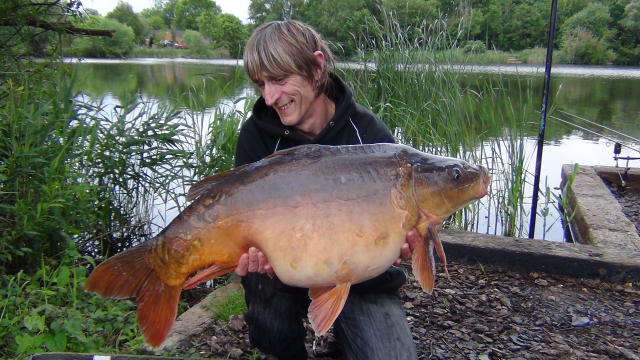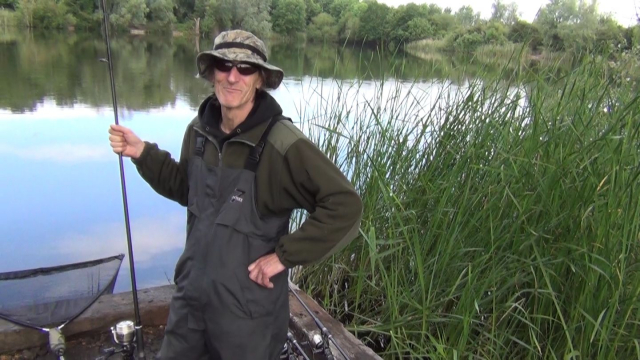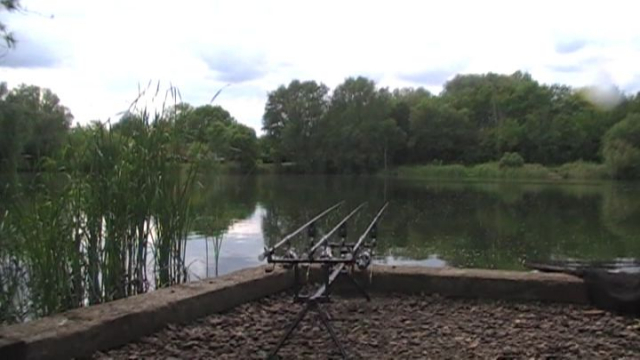
I had been on Willow Lake for 18 hours and overnight conditions had changed dramatically and for the worst. With a chilly north/north easterly and the expected rain coming with a vengeance at 2am, air and water temperatures had begun to drop, which was not good. Carp are simple enough creatures without the vagaries of human emotion, they respond in often predictable ways when the weather changes. The three most important factors affecting water, the aquatic environment and carp are light, temperature and oxygenation. Using these three variables you can come up with optimum times and optimum areas. For instance it’s hot, no wind, oxygen levels are low where are the fish? On the top of course in the shallows and reed beds or it’s been hot all day but a wind has picked up from the shallows blowing to the deeper end of the lake, where are the fish? on the end of the wind, the warmer water is there and it’s getting oxygenated, but not all of them eh? and not always. Angling pressure plays a big part of course but then we did have the entire lake to ourselves this time and that’s always good because they become more predictable as far as there natural habits are concerned.
If you watch my films then you’ll see I am big on weather, for me weather conditions are the biggest influencing factor on any session, it seems to have such a dramatic and immediate effect on the carp and the fishing, more than anything else I would say. We could not live on this planet without the sun, which sounds obvious but it does help make the point that our habits change and are depended on the amount of sun we receive, with carp even more so.
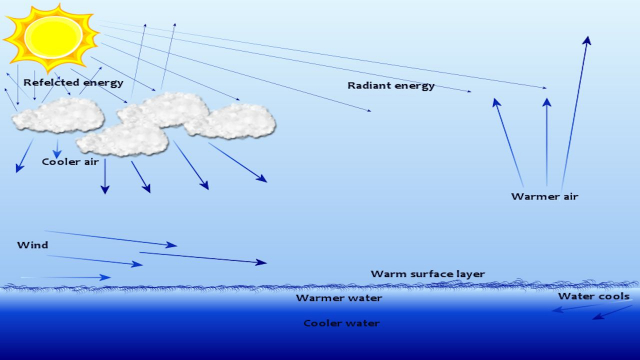
Wind and rain more often than not will cool the water temperature down but also the cloud in the sky will also reflect the suns energy rays too. The energy from the sun’s rays comes in the form of ‘radiant energy’ and when matter absorbs this energy it becomes ‘thermal energy’, it is this that warms the earth, the atmosphere and living creatures. Winds are created by this thermal energy, when heated the particles of air begin to move faster and farther apart causing the same volume of air to become less dense. Lighter air rises and cooler air moves in to replace it as it is denser (heavier), it is this movement of air that causes the wind.
When a wind blows it cools down the lake’s surface and just like air the surface layer of the lake becomes denser with this cooling. This causes the surface layer to sink which in turn is replaced by warmer layers. However when a wind first begins to blow it pushes all the warm water in the surface layer towards the bank that is getting the wind, although some mixing will occur the warmer layer will slide against the cooler layer beneath. Depending on the size of the lake and the strength of the wind you can soon have an area on the windward bank that is significantly warmer than others which is why it can be good to get on a ‘new wind’. Once the warm water has been pushed across the lake to the windward bank it stalls, it cannot go down, because it is lighter than the cold beneath so it will then move along the bank to the right or left and get mixed in with the cooler layers.
This circulation of warmer and cooler water will eventually stop when the water temperature in the lake evens out or the wind drops, however if a wind continues to blow then given the right conditions the back of the wind will begin to warm up and the windward side will be cooler, this is the time to get on the back of an ‘old wind’. The prevailing wind on willow had been a south/south westerly for the previous week and the weather had been warm right up until the evening before, so even with this dramatic change I felt if conditions were to pick up then the fishing would too.
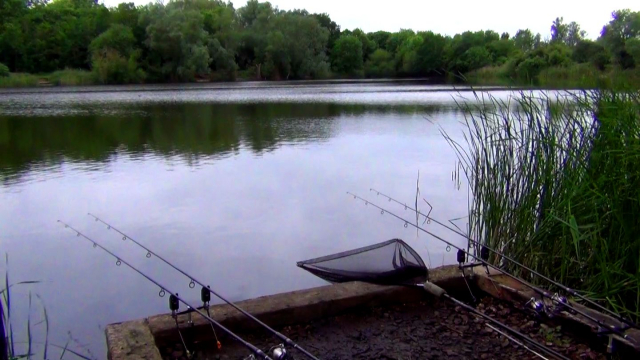
Early on the first morning I started to put in handfuls of bait on both the spots, the prime spot getting twice as much. The coots continued to pester me and even though I tried to feed them off but it was beginning to become a joke. They simply would not leave the bait alone and I lost count of the times they picked up and dropped my hookbait to give me a false run. I always try to manage myself when I am fishing, that’s to say, keeping myself well fed and watered and also in the right frame of mind. So, as far as the coots were concerned I was simply going to ignore them and keep putting the bait in. The prime spot was going to get more bait in an attempt to ‘make something happen’ plus I was going to ‘ring the changes’ with rigs and presentation to see if I could get a bite. I put a forth rod out with a naked choddy with the idea of moving it around to areas I had had fished to previously and any rolling or bubbling carp I saw.
To cheer myself I cooked up a pan of streaky bacon, fried potatoe with plenty of tomato sauce and tabasco plus a nice hot mug of black filter coffee. This always raises my spirits and is as important to me as the fishing. Being skinny, I can eat all I like and what I like, as long as I don’t drink beer, which I don’t. So I always take more food than is needed, plenty of chocolate for instant energy and brioche (easy to eat on an empty stomach first thing) plus good hearty meals, some of which don’t come out of a packet.
At 2 o’clock in the afternoon the left hand rod which was along the margin tore off. I was on the rod in an instant and put on as much side strain as I could but the fish just ripped the rod around, took line and got into the reeds! It happened in seconds but felt like an instant, on, then undeniable off. Gutted and left breathless I sat and re rigged the rod. The line had parted soon after the fish had got into the reeds and I cursed myself for not being ready for it. The spot was in 8 feet deep right next to the reeds which were around 5 feet deep at their edge. When I got run I was on it in an instant, I put on right-hand side strain which, although will bring a fish up to the top will also make the fish ‘kite’ into the bank, straight into the reeds. I felt I should have held the rod high thus negating the side strain ‘kiting’ element and at least introducing some upward motion to the whole affair. I was happy too to bring the fish up as the snag was not above it but to the left. So I played it wrong but possibly learned from it also, so I let it go at that.
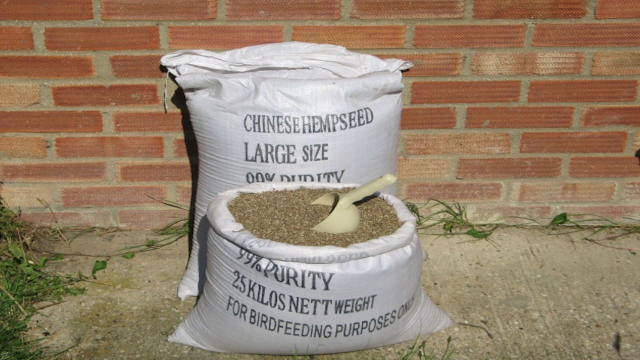
Something that has been with me throughout my life is the amazing feeling I get just being outside in the wild and woolly weather. Hot sunny days do little for me accept sap my strength and it seems make the carp totally disinterested in any bait I present to them, top or bottom. But give me a day of the elements and I am in my glory. So with a good meal down me, a few cuppers and the thought that usually on a Monday I would be at work my spirits were raised.
The bad weather continued with the rain coming down really hard at times, in fact the temperature had dropped so much I needed to raise my feet off the floor and onto a bucket to keep them warmer. But as the day moved on and the rain passed away it bought a much warmer feel to the air. Throughout the day I continued putting in a few good handfuls of bait onto the prime spot as I felt strongly that they were having it but also getting away with it. So what can switch a swim from one that’s not producing to one that is? Numbers, the more carp there is the more competition for the feed bait and the more competition the more likely it is that one will slip up, simple. So putting the bait in little and often, letting them come in and eat it, putting in some more and letting them come in and eat that and in so doing creating a commotion that gets noticed by other carp who instinctively will want to join …well then, you’ve got a party!
That’s the idea, using the bait to create a situation out of nothing and it’s my reason for natural caution against putting in too much bait. Instinct tells me to play the game, to get them on my terms. A very valuable lesson I learned whilst I was hemp fishing for roach was that by adjusting my feeding pattern I would see instant changes in the way they behaved and fed. By feeding little and often to begin with they would, after a while respond more and more confidently and once this was achieved I could get them up in the water and in a frenzy. Bites were often fast and furious when this happened but by adjusting my setup I turned many of those lightning bites into hooked fish. Feeding heavily and less frequently took the fish down to the bottom and I found laying on over depth with a different setup got fewer slower but much more hittable bites.
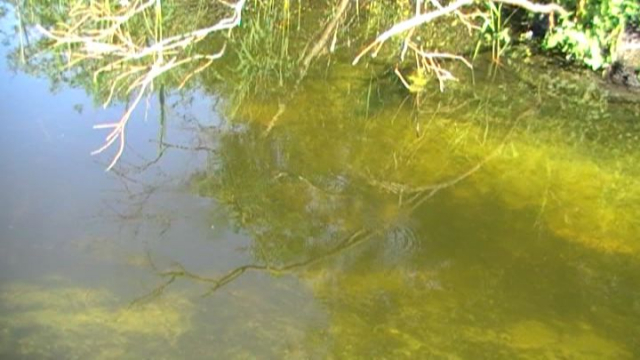
The trouble is most of the time you cannot see into the swim as it’s out in the lake so then you must rely on experience and deductive thinking which can really help in these situations. Just because you have not had a bite does not mean all the bait you have put out is still there on the bottom. You have to weigh that situation up and give it your best shot and it’s not always easy to make the decision. One thing I do like to do is bait margin spots and snags to see if bait is taken and in so doing inform me of any feeding going on. Often I will not fish these spots either and there is a good reason for it.
When I fished Pingles Pool back in 2009 I used to feed the inlet from the drain and watch the carps reaction. After a while the carp got completely used to coming in and feeding, but I never once fished it. Now I can hear many of you asking ‘Why?’ and I will tell you. If ever I wanted to find out if the carp were feeding all I had to do is go and look in the inlet. If the bait was there they were not feeding, and if it was…. Imagine if you will, your sitting there in your swim wondering if the carp are feeding, you haven’t had a touch, you havent seen a single fish showing and you have no idea really whats going on down there. How are you going to know? Now mayby I could of caught one or two fish from there before it blew but it was far more valuable than that to me. I could test any bait and know at anytime if the carp were having it. A real insight and boost to your confidence. Unfortunately one of the lads from the 8 man syndicate could not resist going in and getting one and in so doing blew the area and all my hard work.
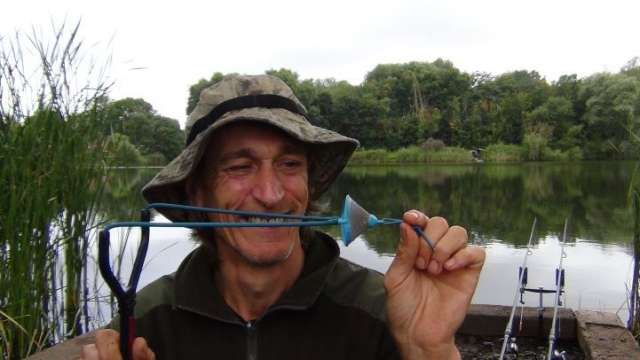
So the bait kept going out onto the prime area a few handfuls at a time, spread out over the two spots. I rang the changes with my rigs and presentation and ignored the coots on the inside line. I made plenty of cuppers and stole myself with a few cigarettes (something I intend on giving up, again! And did :-)).
At 10.45 pm the right hand rod in 9 foot of water in the prime area was away. On picking up the rod the line zipped out into the darkness and I could feel a solid lump on the other end. It started tracking right and pulling away, then the hook pulled. Let’s face it there are not many moments in fishing that are worse and when it happens it feels gutting, especially if you have put in the work, fished through the gruller moments and kept at it. To lose your prize so emphatically, without the merest remorse from the rod in your hand, well you can end up throwing that rod into the reeds, in a fit of anger, letting yourself down even more which in the long silent moments that follow, you will also have to come to terms with. So I shook it off re-rigged the rod and set to the task of getting three more good handfuls out in the darkness, which brings me onto catapults...
I have four catapults but use only one, the other three hang up in my fishing room/study all of them designed for carp anglers. The one I use and have most faith in though is the Drennan Match-Caty. I once showed this to Rob Farrent whilst fishing the Woolpacks Lake #3. Now Rob is one of the best anglers I met on the woolpack and obviously knows how to get the best from his kit but when I showed him the Match caty and how accurate it was and how far you could get boilies he went out and got one straight away, I was impressed by that. I can get my bait exactly where I want it with this caty. Ok so it takes a bit longer if you’re piling it in whilst baiting up as the pouch is smaller but then I can work with it quicker and more rhythmically too and it’s consistently accurate. During the darkness you often cannot see where you bait is landing so this is when directional markers like trees etc. and a reliable catapult come’s into its own. This all goes to help that feeling of just letting it flow, not being worried by the trivial things as they are taken care of.
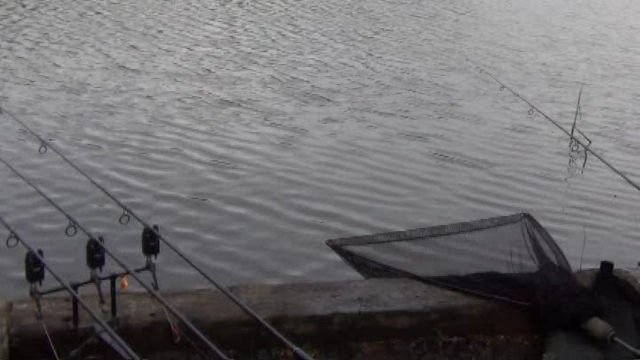
At 8.15 am the middle rod in 7 foot of water from the prime area took off, for some reason I pointed the camera at it and momentarily caught it on film but then in an instant the camera was down and the rod was in my hand. The rod pulled over and a good lump was felt on the end, I throttled any thought of a repeat of last night’s loss and concentrated as hard as could. Slowly the fish came up in the water as it tracked right. When it got to the top it rolled and I could clearly see it was a monster, it pulled hard and line started to get pulled from the clutch. I let it go, there was no weed or snags for it to find and as long as the hook hold held...
The run stopped and the fish rolled again this time changing direction and coming straight into the bank too my right, to stop it kiting into the bank on the 50 or so yards of line I had out. I quickly changed the direction of pull from left hand side strain to right hand side strain affectively pulling the carp towards me and into my bank, this had the desired effect and the carp started to turn and pull out left and away from the bank.
I wound down bringing it closer and closer, once it got within a few meters of the bank it turned powerfully, rolled on the surface and tore off again up the margin. More right hand side strain had it moving out from the bank and taking line again but once again I let it go. I really wanted to get this fish in, it was a biggun’ there was no doubt of that I had seen it a few meters away rolling, bigger than anything I had seen on the end of my line before. If I lost this fish too then it would be over, finished that’s it. Once again I pushed these thoughts from my head and waited for my chance. The fish rolled again and turned into the bank, I slid my net into the water and crouched gently pumping the rod and winding down the line, closer and closer and with net outstretched she was mine.
I called over to Gary, Got a lump mate!.
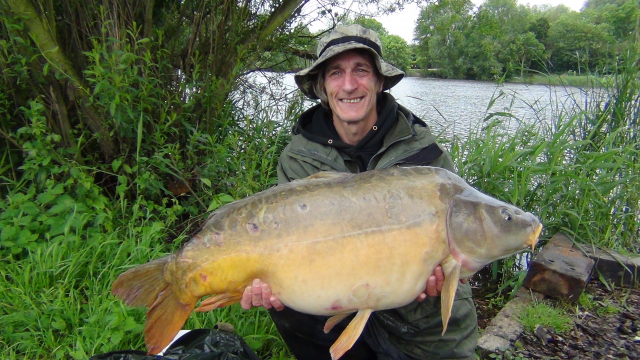
It’s always a special moment when you reach a milestone. When I started carping on June 16th 1980, Richard Walker held the record with a 44lb common from Redmire pool which had literally been broken on that morning by Chris Yates with the first ever British 50. Twenties only grew in Kent there were no boilies, no hair rigs, no carbon fibre, no bedchairs, bivvies, spods, coated braids, korda, nash etc. etc. I had never sought to catch a twenty then a thirty a forty, to fish for named fish on known waters, indeed I had always gone for the adventure, seeking the challenge wherever I fished.
If you fish a water with 40lb carp in it then eventually you likely to catch one, and so I did, but it was special, a journey completed in some ways, one I had thought about on countless occasions. We all have dreams and it’s nice when they come true, especially through effort.
You can watch all these sessions on Willow lake here https://thecarpcatcher.co.uk/thecarpcatchers_blog.php?post=37

Steve Whitby

